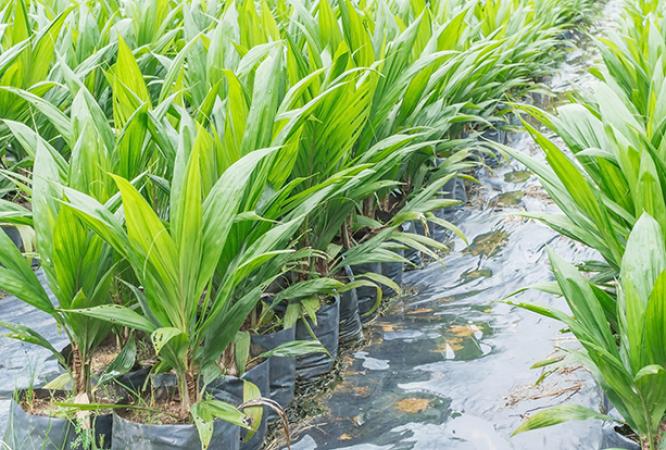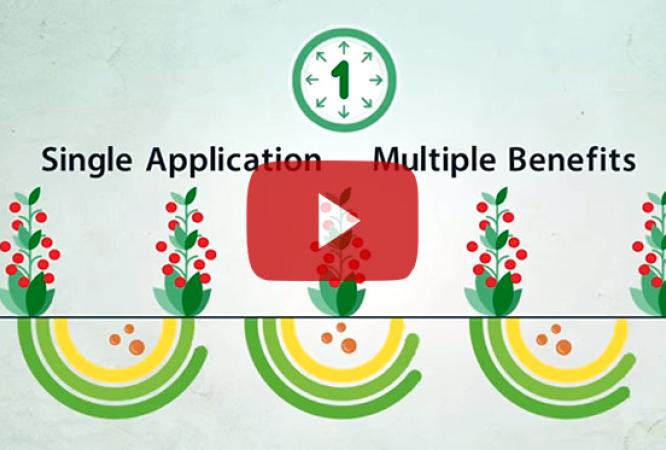A single application of Haifa Bonus NPK® was evidenced as effective in the soybean productivity increase and economically feasible.
|
PURPOSE
|
|||||||||||||||||||||||||||||||||||||||||||||||||||||||||||||||||||||||||||||||||||||||||
|
The experience was conducted at Centro de Pesquisa e Tecnologia do Oeste Baiano, Fundação Bahia, in the city of Luís Eduardo Magalhães, Bahia in the period between November 2014 and April To evaluate the effect from foliar application of Haifa Bonus NPKâon the morphological characteristics and productivity of soybean culture.
|
|||||||||||||||||||||||||||||||||||||||||||||||||||||||||||||||||||||||||||||||||||||||||
|
MATERIAL AND METHODS
|
|||||||||||||||||||||||||||||||||||||||||||||||||||||||||||||||||||||||||||||||||||||||||
|
Table 1. Chemical and physical characterization of the soil (YELLOW LATOSOL ) at depth 0 to 0.2 m (Luís Eduardo Magalhães, Bahia. 2014).
MO: K2Cr2O7; pH: CaCl2; P, Ca, Mg, K, Cu, Fe, Mn and Zn: Mehlich 1; Al: KCl; H+Al: SMP; S: Ca(H2PO4)2; B: hot water.
Soybean seeds MSOY 9144 RR®, treated with Fluazinam + Thiophanatemethyl (Certeza® - 2,0 mL kg-1stes), Fipronil (Belure® - 2,0 mL kg-1stes) and Inoculant (Masterfix L® - 2.0 ml kg-1stes or 1.109 cells kg stes), were sowed mechanically on 11/24/14 (sprout on 11/29/14), with fertilization with 400 kg ha-1 of Phosmix 270 M1 Galvani 02-25-00 (7% S, 0.08% B, 0.05% Cu, 0.2% Mn and 0.15% Zn) into the sowing furrow, and superficial application of 200 kg ha-1 of 00-00-60 at 26 DAE. The experiment, delineated in random blocks with five repetitions, comprised four treatments (Table 2), and each experimental parcel comprised by seven sowing rows spaced by 0.5 m, eight meters long. Upon the harvest (04/11/15), the plant population, plant height, insertion height of the 1st pod, 1,000-grain mass and soybean productivity (moisture corrected to 13%) were evaluated, and the data was submitted to variance analysis and the mean figures were compared by the Tukey test (p0.05).
Table 2. Description of treatments used in soybean culture (Luís Eduardo Magalhães, Bahia. 2014).
Haifa Bonus NPK (13% N, 2% P2O5, 41% K2O).Application rate (“broth” volume): 150 L ha-1.
|
|||||||||||||||||||||||||||||||||||||||||||||||||||||||||||||||||||||||||||||||||||||||||
|
RESULTS AND DISCUSSION
|
|||||||||||||||||||||||||||||||||||||||||||||||||||||||||||||||||||||||||||||||||||||||||
|
The mean population achieved was 200,417 plants ha-1, that is 10.02 plants m-1. The insertion heights of the first pod and plant heights were not influenced by the treatments, presenting mean values of 0.14 m and 1.05 m, respectively
For 1,000-grain mass, no effect was also verified from the application of Haifa Bonus NPK®, both for dosage and period, and a mean value of 126.41 g was achieved (Table 3).
The single application of 40 g L-1 of Haifa Bonus NPK® (6.0 kg ha-1) during phenological stage R3 was evidenced as effective, and reflected in increments around 965 kg ha-1 grains (Table 3). The utilization of Haifa Bonus NPK® was economically feasible, as it increased the revenue by R$ 1,009.00 ha-1, with cost of R$ 19.14 ha-1, and return of R$ 989.90 ha-1.
The application of higher dosage, that is, 80 g L-1 of Haifa Bonus NPK®(12.0 kg ha-1), but distributed in two periods, pre-sprout (Vn) and pod formation start (R3) and grain formation start (R5.1), did not present significant gains when compared to the control management (absence of application of Haifa Bonus NPK®).
Table 3. 1,000-grain mass and soybean productivity vs. doses and application periods of Haifa Bonus NPK®(Luís Eduardo Magalhães, Bahia. 2015).
1 F Test: *e ** significant at 5% and 1% probability, respectively, and ns non-significant. Mean figures followed by the same letter do not differ each other by the Tukey test at 5% probability. : general mean. CV: variation coefficient. DMS: minimum significant difference.
|
|||||||||||||||||||||||||||||||||||||||||||||||||||||||||||||||||||||||||||||||||||||||||
|
CONCLUSION
|
|||||||||||||||||||||||||||||||||||||||||||||||||||||||||||||||||||||||||||||||||||||||||
|
The single application of Haifa Bonus NPK® was evidenced as effective in the soybean productivity increase and economically feasible.
|
|||||||||||||||||||||||||||||||||||||||||||||||||||||||||||||||||||||||||||||||||||||||||
|
BIBLIOGRAPHICAL REFERENCES
|
|||||||||||||||||||||||||||||||||||||||||||||||||||||||||||||||||||||||||||||||||||||||||
|
CAMARGO, O.A. et al. Métodos de análise química, mineralógica e física de solos. Campinas: IAC, 1986. 77p.
EMPRESA BRASILEIRA DE PESQUISA AGROPECUÁRIA - CENTRO NACIONAL DE PESQUISAS DE SOLOS. Sistema Brasileiro de Classificação de Solos. Brasília: Embrapa Produção de Informação, 2013. 353p.
RAIJ, B. van. et al. Análise química para avaliação da fertilidade de solos tropicais. Campinas: Instituto Agronômico, 2001. 285p.
|
|||||||||||||||||||||||||||||||||||||||||||||||||||||||||||||||||||||||||||||||||||||||||






